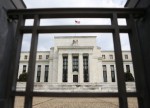Summary
Prepared at the Federal Reserve Bank of New York and based on information collected on or before April 7, 2008. This document summarizes comments received from businesses and other contacts outside the Federal Reserve and is not a commentary on the views of Federal Reserve officials.
Reports from the twelve Federal Reserve Districts indicate that economic conditions have weakened since the last report. Nine Districts noted slowing in the pace of economic activity, while the remaining three--Boston, Cleveland, and Richmond--described activity as mixed or steady.
Consumer spending was characterized as softening across most of the country, with some Districts reporting year-over-year declines in retail and/or auto sales. In contrast, tourism was generally described as strong, with a number of Districts noting particular strength in foreign visitors. Reports on nonfinancial services varied by District: demand for transportation services was generally characterized as weak, while business and health services continued to expand; other service industries were said to be mixed. Trends in manufacturing also varied across Districts. Reports on real estate and construction were generally anemic for the residential sector; activity in the commercial sector has slowed. Financial institutions in many Districts indicated some deceleration in consumer loan demand, tightening in lending standards, and deterioration in asset quality. Most Districts reported improved conditions in the agricultural sector and robust activity in the energy industry.
Labor markets were mostly described as weakening since the last report, though a few Districts reported ongoing shortages of skilled workers and some Districts noted wage pressures. Increases in input costs were widespread, accompanied by somewhat smaller rises in selling prices.
Consumer Spending and Tourism
Consumer spending weakened in most, but not all, Districts since the last report. In particular, automobile sales were generally reported to be flat or declining. Vehicle sales were described as unchanged or falling in the Philadelphia, Cleveland, Atlanta, and Dallas Districts and were characterized as weak in the Richmond, Atlanta, Chicago, and San Francisco Districts. However, Kansas City reported that auto sales rebounded in March, though they remained lower than a year earlier. Non-auto retailers reported that sales were sluggish or declining in ten Districts. Elsewhere, Boston noted mixed sales trends, and New York reported a modest pickup since the last report. Chicago, San Francisco, and, to a lesser extent, Philadelphia noted relative strength in demand for luxury goods.
Retail inventories were generally reported to be steady or rising. Automobile inventories were said to be accumulating in the Philadelphia and Atlanta Districts. Among non-auto retailers, despite weakness in sales, only a few reported any notable inventory accumulation; Atlanta cited some increase in inventories, while the Richmond and San Francisco Districts noted that some inventory accumulation has prompted retailers to cancel orders.
Despite the general weakness in consumer spending, tourism was generally described as robust, with that strength, in a number of instances, attributed to international visitors. The Boston, New York, Atlanta, Minneapolis, and Kansas City Districts reported strong tourism activity, while the Richmond and Chicago Districts described that sector as mixed, with pockets of strength. San Francisco indicated mixed but generally weak tourism activity. Reports from Boston, Atlanta, Chicago, and Minneapolis specifically cited foreign visitors as a source of strength.
Nonfinancial Services
Activity in the service sector was mixed across Districts and across industries since the last report. Looking at the service sector in broad terms, Boston, Richmond, and Minneapolis reported some revenue growth; New York and St. Louis noted some softening; and San Francisco saw some deceleration. A number of Districts reported weakness in transportation services: New York, Philadelphia, Cleveland, Atlanta, and Dallas described shipping and freight activity as sluggish or weakening, with New York attributing the softening to declining import volume at the port. Richmond ports also noted weakening in imports but robust export activity. There were scattered reports of continued expansion in some other service industries, such as business services (Boston, Philadelphia, St. Louis, Minneapolis) and health care (Chicago, San Francisco).
Manufacturing
Manufacturing activity was varied, with some Districts reporting a slight increase in activity, some indicating weaker activity, and several noting that activity was mixed or had held steady. Chicago, Boston, and Richmond reported that activity was rising, but not substantially, while New York, Kansas City, Philadelphia and Dallas all reported that activity had weakened. St. Louis and Cleveland said that activity had held steady, while Atlanta, Minneapolis and San Francisco saw activity as mixed.
Demand was reported as strong for aerospace, aircraft, and defense goods, as well as for steel and food. Automakers increased production modestly in the Cleveland and Chicago Districts, but vehicle production declined in the Atlanta district. The Philadelphia District found that that demand for metals and machinery had increased. Many Districts cited strong exports generally. Most Districts saw a continued slide in the demand for goods related to residential construction. Excess capacity led to production declines in the high-tech industry in the Dallas District, and Chicago reported weak demand for heavy equipment. Uncertainty about economic conditions is leading to a varied, but generally subdued, outlook for manufacturers.
Real Estate and Construction
Housing markets and home construction remained sluggish throughout most of the nation, though there were few signs of any quickening in the pace of deterioration. Ongoing weakness in housing markets, in general, was reported in almost all Districts. Sales activity was generally reported to be declining in the Boston, New York, Philadelphia, Atlanta, St. Louis, Minneapolis, Dallas and San Francisco Districts, while Kansas City and Chicago noted slack demand and excess inventories. On the other hand, the Cleveland District saw some pickup in activity, while Richmond and Atlanta reported some pockets of improvement; Boston, Atlanta, and Chicago cited some recent pickup in traffic or buyer inquiries. New residential construction was reported to have remained at depressed levels, and none of the Districts reported any pickup since the last report.
Declines or downward pressures in selling prices were specifically reported in the Boston, New York, Philadelphia, Richmond, Atlanta, Chicago, Minneapolis, Kansas City, and San Francisco Districts. In particular, New York and San Francisco noted some incipient price declines in areas that had previously shown resilience--respectively, New York City and the Pacific Northwest, as well as Utah. On the other hand, the Cleveland District noted some stabilization in home prices.
Commercial real estate markets were generally reported to be steady or softening in most areas. Weaker conditions in the rental market were reported in eight Districts: New York, Philadelphia, Richmond, Atlanta, Chicago, St. Louis, Minneapolis, and San Francisco. On the other hand, the leasing market was found to be steady in Boston, Kansas City and Dallas. Reports on commercial development were mixed with activity having weakened in the Philadelphia, Atlanta, and San Francisco Districts, but having increased in the Cleveland, Chicago, and Kansas City Districts. St. Louis characterized commercial construction as strong. However, sales of commercial properties were generally indicated to be sluggish, while prices were said to be under downward pressure. The Boston, Philadelphia, Minneapolis, Kansas City, Dallas, and San Francisco Districts all reported weakness in commercial real estate sales and prices.
Banking and Finance
Banks reported mixed trends in lending activity, with fairly widespread slowing in the consumer segment but some stabilization, at low levels, in residential mortgage activity. Overall lending activity was reported to have increased in the Philadelphia, Richmond and St. Louis Districts, but to have declined in the New York, Chicago, Kansas City and San Francisco Districts. Dallas described lending activity as steady but soft. Lending activity for new home mortgages, though generally characterized as sluggish, was reported to have stabilized in the New York, Cleveland, Chicago, and San Francisco Districts. Consumer loan demand, however, weakened in a number of Districts: New York, Atlanta, Chicago, and Kansas City.
Credit quality was reported to have deteriorated, on balance, since the last report. Increased delinquency rates were noted by New York, Philadelphia, and Cleveland, while Kansas City reported that loan quality remained lower than a year ago. Widespread tightening in credit standards was reported, especially on residential and commercial real estate loans. In general, banks were reported to be tightening credit standards in the New York, Cleveland, Atlanta, Chicago, Kansas City, Dallas and San Francisco Districts. In addition, Boston noted that standards remain tight on commercial mortgages, while Philadelphia indicated that banks are limiting lending in this category. Richmond indicated tighter standards on residential mortgages.
Agriculture and Natural Resources
Agricultural reports were generally upbeat, with most respondents citing improved growing conditions and favorable pricing. Although drought conditions continued to persist in some areas of the Atlanta and Richmond Districts, soil moisture was adequate for spring planting, in part, due to increases in precipitation in March and early April. Reports from the Chicago, Kansas City, and St. Louis Districts indicated that cool temperatures, dry conditions, or flooding toward the end of March damaged some winter crops and delayed field preparations for spring plantings. Farmers in the Chicago, Kansas City, Minneapolis, and St. Louis Districts all reported plans to shift production away from corn toward soybeans in 2008, in part, because of favorable soybean prices and elevated corn production costs. Some farms in the San Francisco District expressed concern over prolonged drought conditions and pending cuts in water deliveries. Dairy and livestock producers in the Chicago, Dallas, Kansas City, and San Francisco Districts expressed concern that increased feed costs had reduced margins.
Districts reporting on energy continued to see robust levels of activity and steady to increasing prices. In the Dallas District, drilling remained strong and natural gas production has continued to increase. In the Minneapolis District, expansion of the mining industry was underway, while oil and gas exploration remained robust. In general, contacts contended that increased demand for energy was expected to continue to boost activity and prices.
Labor Markets
Despite some variation across Districts, employment levels appeared to be little changed, on balance, from recent months. Some weakening in the job market was reported in the New York, Atlanta, Chicago, St. Louis, and Minneapolis Districts. Cleveland reported flat employment levels, while Richmond indicated mixed trends. Boston and Kansas City indicated modest increases in employment, with some deceleration indicated in the latter. Firms in the Philadelphia, Atlanta, and Minneapolis Districts reported layoffs, reductions in work hours, or hiring freezes in response to current or expected slowing in economic activity.
Despite the general softening in their markets overall, Atlanta and Chicago noted scattered shortages of skilled workers in various service industries. Dallas reported relatively tight labor market conditions overall and cited shortages of managers and engineers, as well as farm workers. Staffing and temp agencies reported mixed trends in labor demand: New York, Richmond, and Chicago reported some softening, whereas Cleveland and Dallas note some pickup. In the financial services industry, some weakening in employment trends was reported in the New York, Chicago and St. Louis Districts, and San Francisco noted job losses in firms servicing the real estate industry.
Prices
Business contacts across all Districts continued to report increases in input costs and output prices. In particular, price increases were consistently reported for food products, fuel and energy products, and many raw materials. More specifically, increases in the price of chemicals, metals, plastics and other petroleum-based products were commonly cited. Most manufacturers have or are planning to increase prices in response to rising input costs, while the response of service firms has been more mixed, in part due to differences in competitive pressures. On balance, input costs have risen more rapidly than output prices, putting pressure on margins for many firms. Most Districts reported little change in retail price inflation, though Richmond and San Francisco noted some moderation. Most business contacts reported that wages were unchanged or were increasing moderately in all Districts. Business contacts in the Atlanta, Chicago, Cleveland, Dallas, Philadelphia, and San Francisco Districts indicated that there has been some upward wage pressure for skilled labor in some sectors that continue to experience shortages.








Add a Comment
We encourage you to use comments to engage with other users, share your perspective and ask questions of authors and each other. However, in order to maintain the high level of discourse we’ve all come to value and expect, please keep the following criteria in mind:
Enrich the conversation, don’t trash it.
Stay focused and on track. Only post material that’s relevant to the topic being discussed.
Be respectful. Even negative opinions can be framed positively and diplomatically. Avoid profanity, slander or personal attacks directed at an author or another user. Racism, sexism and other forms of discrimination will not be tolerated.
Perpetrators of spam or abuse will be deleted from the site and prohibited from future registration at Investing.com’s discretion.